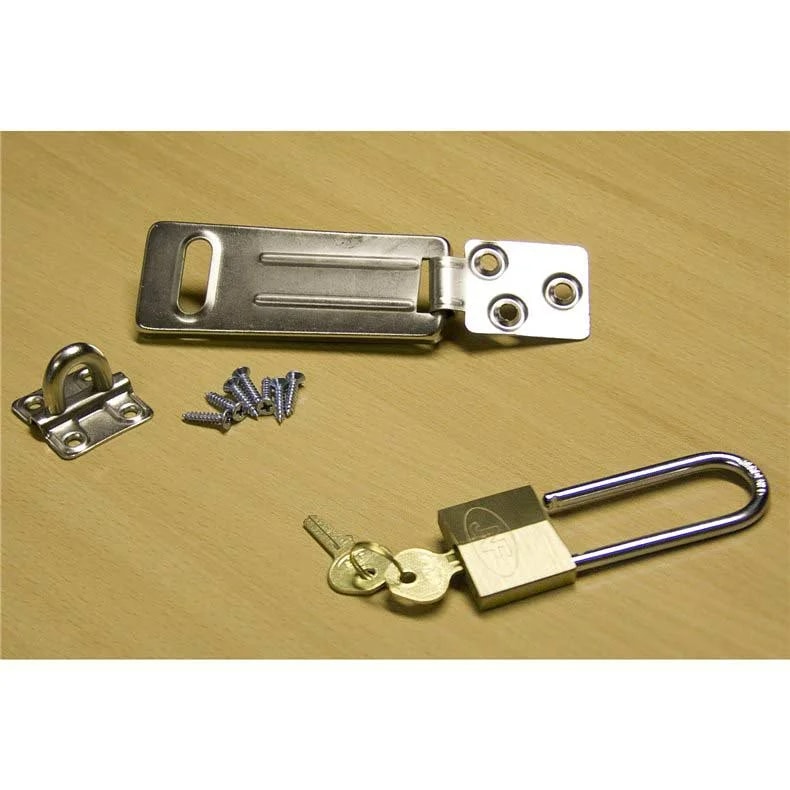Jump to:
Garden sheds are valuable spaces for storage, but they can also be targets for theft. In this blog, we’ll focus on a simple yet effective solution: fitting a hasp and staple. These small but powerful hardware additions can significantly enhance your shed’s security. We’ll walk you through the process, so read on and let’s get started!
What Are Hasps and Staples?

A hasp and staple are simple yet effective security devices often used to secure doors and gates. In our case, sheds. The hasp is a flat metal plate with a hinged part, while the staple is a U-shaped metal loop. When the hasp is closed over the staple and secured with a padlock for shed door, it forms a robust barrier.
These hardware essentials come in various types and materials. Hasps and staples can be found in stainless steel, brass, and hardened steel. Each provides varying degrees of strength and resistance to weathering.
Choosing the right hasp and staple for your garden shed is crucial. Consider the type of door your shed has, how often you use the structure, and where it’s located. Opting for weather-resistant materials ensures durability. Meanwhile, selecting the right size and strength safeguards against forced entry attempts.
With these basics, you can choose wisely and improve your storage shed’s security.
Tools and Materials Needed
For a successful hasp and staple installation, you’ll need a few essentials, including:
- Measuring tape for precise placement
- Screwdriver for attaching the hardware
- Level for proper alignment
- Pencil for marking
- Power drill for making installation easier
You’ll also need the hasp and staple set, which is like a lock made of strong materials such as stainless or tough steel. The BillyOh Deluxe Padlock and Hasp, for one, sets a prime example. Screws are also required to attach this lock to your wooden shed securely.
Having all these items ensures an easy setup and helps make your storage house more secure.
Assessing Your Garden Shed
When assessing your outdoor building, start by identifying vulnerable spots. Check for any weak points in the walls or areas that may be easily accessible to potential intruders. Pay special attention to the door, windows, and corners. Next, consider the material and structure of your shed’s door. Different doors have different strengths. So, the hasp and staple you choose should complement these. For instance, a wooden door may need a different type of hasp and staple compared to a metal one.
This evaluation ensures that you’re addressing specific security needs. It makes the installation more effective in safeguarding your garden shed.
Installation Process
Let’s break down the step-by-step process to ensure a secure installation:
Marking and measuring
- Begin by measuring and marking the best spot for the hasp and staple.
- Consider the ideal height and alignment for efficient operation.
Preparing the surface
- Ensure a clean surface for installation by cleaning and preparing it.
- Create a smooth and secure attachment point for the hasp and staple.
Installing the hasp
- Attach the hasp to the shed door using screws.
- Guarantee proper alignment for the hasp, enhancing its effectiveness.
Mounting the staple
- Place and align the staple on the shed frame.
- Ensure a snug fit for added security against potential break-ins.
Securing with padlock
- Choose a suitable padlock that complements the hasp and staple.
- Utilise proper locking techniques to maximise security.
This simple guide gives you the confidence to protect your tools and equipment. By following the steps, you’ll securely install the hasp and staple, making your garden shed safer.
Additional Tips for Security
To fortify the security of your new shed, consider these additional measures:
Reinforce other vulnerable points
Examine windows, hinges, and any other potential weak spots. Strengthen these areas with additional locks, security bars, or reinforced materials.
Enhance lighting and visibility
Install motion-sensor lights around the shed perimeter. Adequate lighting deters intruders and improves overall visibility.
Ensure longevity with maintenance
Regularly inspect the hasp and staple for signs of wear or rust. Apply lubricant to moving parts and tighten any loose screws. Consider repainting or resealing the hardware to protect against weathering.
Take simple steps to make your garden shed more secure. Strengthen weak points, add good lighting, and regularly maintain the hasp and staple. This, overall, ensures better protection against potential threats.
Round-up
Making your garden shed secure is simple but important. Follow the steps, and prioritise regular upkeep to keep everything working well. A protected shed means your tools and equipment stay safe, giving you peace of mind. So, take charge of your shed’s security and enjoy worry-free gardening.
Explore our diverse selection of shed door locks at Garden Buildings Direct. Our offerings include budget-friendly options such as cheap safes.
Up next on your reading list: What Is a Hasp and Staple?





